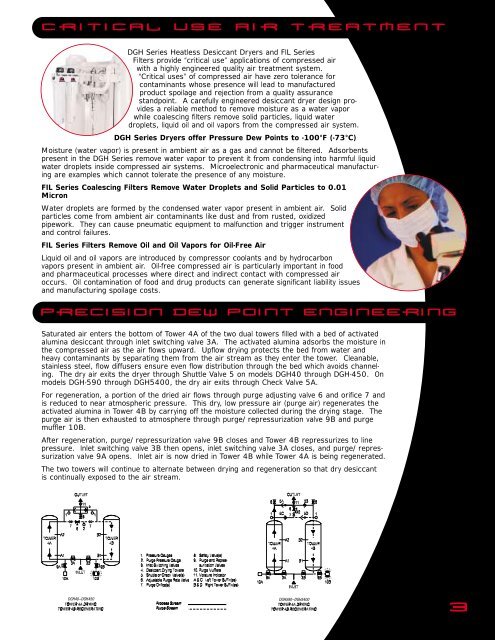dgh series - Dearing Compressor and Pump Company
dgh series - Dearing Compressor and Pump Company
dgh series - Dearing Compressor and Pump Company
You also want an ePaper? Increase the reach of your titles
YUMPU automatically turns print PDFs into web optimized ePapers that Google loves.
CRITICAL USE AIR TREATMENT<br />
DGH Series Heatless Desiccant Dryers <strong>and</strong> FIL Series<br />
Filters provide “critical use” applications of compressed air<br />
with a highly engineered quality air treatment system.<br />
“Critical uses” of compressed air have zero tolerance for<br />
contaminants whose presence will lead to manufactured<br />
product spoilage <strong>and</strong> rejection from a quality assurance<br />
st<strong>and</strong>point. A carefully engineered desiccant dryer design provides<br />
a reliable method to remove moisture as a water vapor<br />
while coalescing filters remove solid particles, liquid water<br />
droplets, liquid oil <strong>and</strong> oil vapors from the compressed air system.<br />
DGH Series Dryers offer Pressure Dew Points to -100°F (-73°C)<br />
Moisture (water vapor) is present in ambient air as a gas <strong>and</strong> cannot be filtered. Adsorbents<br />
present in the DGH Series remove water vapor to prevent it from condensing into harmful liquid<br />
water droplets inside compressed air systems. Microelectronic <strong>and</strong> pharmaceutical manufacturing<br />
are examples which cannot tolerate the presence of any moisture.<br />
FIL Series Coalescing Filters Remove Water Droplets <strong>and</strong> Solid Particles to 0.01<br />
Micron<br />
Water droplets are formed by the condensed water vapor present in ambient air. Solid<br />
particles come from ambient air contaminants like dust <strong>and</strong> from rusted, oxidized<br />
pipework. They can cause pneumatic equipment to malfunction <strong>and</strong> trigger instrument<br />
<strong>and</strong> control failures.<br />
FIL Series Filters Remove Oil <strong>and</strong> Oil Vapors for Oil-Free Air<br />
Liquid oil <strong>and</strong> oil vapors are introduced by compressor coolants <strong>and</strong> by hydrocarbon<br />
vapors present in ambient air. Oil-free compressed air is particularly important in food<br />
<strong>and</strong> pharmaceutical processes where direct <strong>and</strong> indirect contact with compressed air<br />
occurs. Oil contamination of food <strong>and</strong> drug products can generate significant liability issues<br />
<strong>and</strong> manufacturing spoilage costs.<br />
PRECISION DEW POINT ENGINEERING<br />
Saturated air enters the bottom of Tower 4A of the two dual towers filled with a bed of activated<br />
alumina desiccant through inlet switching valve 3A. The activated alumina adsorbs the moisture in<br />
the compressed air as the air flows upward. Upflow drying protects the bed from water <strong>and</strong><br />
heavy contaminants by separating them from the air stream as they enter the tower. Cleanable,<br />
stainless steel, flow diffusers ensure even flow distribution through the bed which avoids channeling.<br />
The dry air exits the dryer through Shuttle Valve 5 on models DGH40 through DGH-450. On<br />
models DGH-590 through DGH5400, the dry air exits through Check Valve 5A.<br />
For regeneration, a portion of the dried air flows through purge adjusting valve 6 <strong>and</strong> orifice 7 <strong>and</strong><br />
is reduced to near atmospheric pressure. This dry, low pressure air (purge air) regenerates the<br />
activated alumina in Tower 4B by carrying off the moisture collected during the drying stage. The<br />
purge air is then exhausted to atmosphere through purge/repressurization valve 9B <strong>and</strong> purge<br />
muffler 10B.<br />
After regeneration, purge/repressurization valve 9B closes <strong>and</strong> Tower 4B repressurizes to line<br />
pressure. Inlet switching valve 3B then opens, inlet switching valve 3A closes, <strong>and</strong> purge/repressurization<br />
valve 9A opens. Inlet air is now dried in Tower 4B while Tower 4A is being regenerated.<br />
The two towers will continue to alternate between drying <strong>and</strong> regeneration so that dry desiccant<br />
is continually exposed to the air stream.<br />
3



